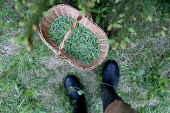


Willie Smits: Village Based Permaculture Approaches in Indonesia (video)
will be released to subscribers in:
soon!



 5
5











 7
7




Visit Redhawk's soil series: https://permies.com/wiki/redhawk-soil
How permies.com works: https://permies.com/wiki/34193/permies-works-links-threads
 3
3











 3
3




from https://www.thekitchn.com/7-tips-to-make-sure-your-jam-sets-up-193268When you're making jam with traditional amounts of sugar, you're aiming to cook it to 220°F. That's the temperature at which sugar forms a gel and can bond with the pectin (whether it naturally occurring in the fruit or you've added it).
Visit Redhawk's soil series: https://permies.com/wiki/redhawk-soil
How permies.com works: https://permies.com/wiki/34193/permies-works-links-threads

 8
8




How Permies works: https://permies.com/wiki/34193/permies-works-links-threads
My projects on Skye: The tree field, Growing and landracing, perennial polycultures, "Don't dream it - be it! "
 6
6






 3
3




Jay Angler wrote:
from https://www.thekitchn.com/7-tips-to-make-sure-your-jam-sets-up-193268When you're making jam with traditional amounts of sugar, you're aiming to cook it to 220°F. That's the temperature at which sugar forms a gel and can bond with the pectin (whether it naturally occurring in the fruit or you've added it).
I did specify a "candy thermometer" - not just any one will have the necessary accuracy. I tried faking it with my meat thermometer and it didn't jell. That said, they aren't hard to find - I suspect places like Canadian Tire or Home Hardware would have them.







 3
3











 3
3




How permies.com works
What is a Mother Tree ?
 5
5




r ranson wrote:
How about you? How do YOU tell when the jam is set?


 5
5




So long as it goes up to 240F at least, it should work fine.How about a milk thermometer? Like for making cheese?
It doesn't just have to be apples - here's a link to a recipe from Leda Meredith for homemade fruit pectin from oranges - https://www.motherearthnews.com/real-food/canning/fruit-pectin-zerz1509zbayShe was too frugal to buy ingredients in her older age and started making jam before things like pectin or foreign imported apples were available.
Visit Redhawk's soil series: https://permies.com/wiki/redhawk-soil
How permies.com works: https://permies.com/wiki/34193/permies-works-links-threads
 6
6




r ranson wrote:My grandmother used to make jam from what they grew. She was too frugal to buy ingredients in her older age and started making jam before things like pectin or foreign imported apples were available.
I'm not going to be quite as strict as she was, as I can't seem to grow strawberries, but the rest of the fruit I want to make from the harvest. It's the start of berry season here and apples won't be ready for months.
How about you? How do YOU tell when the jam is set?












 2
2




How Permies works: https://permies.com/wiki/34193/permies-works-links-threads
My projects on Skye: The tree field, Growing and landracing, perennial polycultures, "Don't dream it - be it! "

 5
5




Failure is a sign of activity and learning. It had nothing to do with under achievement
I never want to have a team member who has never failed - They are not doing!! 👍
 4
4




 6
6




Nothing ruins a neighborhood like paved roads and water lines.
 2
2




Lorinne Anderson: Specializing in sick, injured, orphaned and problem wildlife for over 20 years.
 3
3




Mark Reed wrote:Someone said to "boil the hell out of it" and that is what I do. Peaches, strawberries, grapes or what ever it is. I don't really care all that much about consistency or appearance. What I'm after is that it is preserved and most importantly tastes good.
Like I mentioned, I don't really know what to call it. It's got globs of fruit, its sticky and gooey. Compared to a lot of jams or jellies it looks awful but if it's made from peaches, it tastes like peaches, if it's made from grapes it tastes like grapes and so on. If it's made from wild black cherries it's incredible.
JayGee
 3
3




 2
2




Jay Angler wrote:True ... and use some Pomona's Pectin on them.
Thank you in advance to everyone for their replies, help, and suggestions! Forgive me if I miss any replies, I'm still learning how to keep up with threads I participate in!

|
Chop wood, carry water. Find enlightenment. Chop wood, carry water, and read tiny ads.
The new kickstarter is now live!
https://www.kickstarter.com/projects/paulwheaton/garden-cards
|





